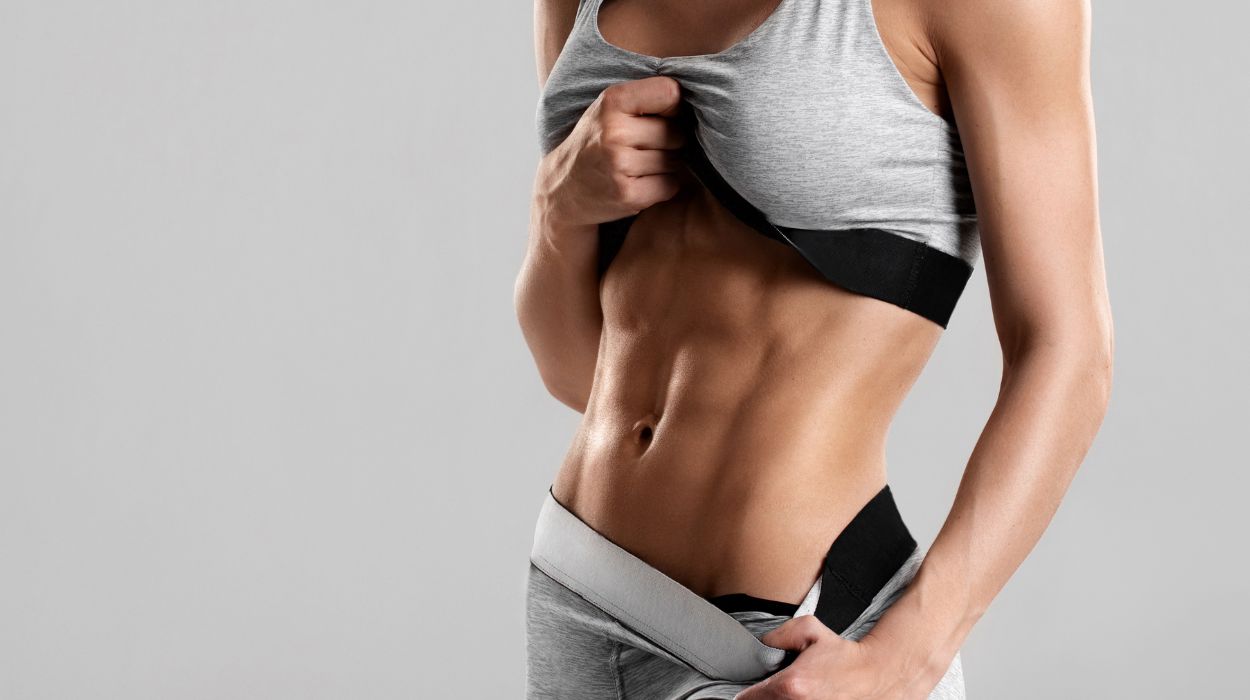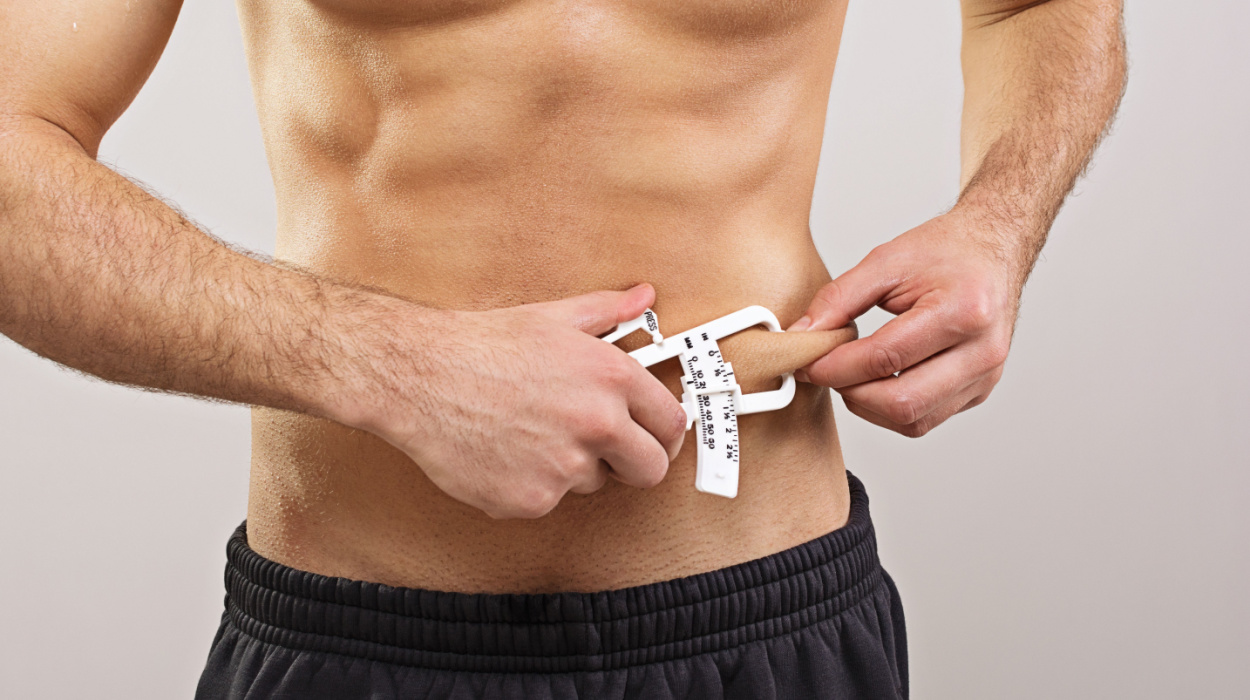Finding ways to live a healthy and happy life is a goal many people have from a young age. It’s not uncommon to want to learn how to lower body percentage[1] or lose belly fat. Thankfully, there are many ways to lower body fat percentage and live a healthy life.
A lower body fat percentage can even improve your mental health.[2] This article explores different ways to burn fat and hinder weight gain. Too much body fat can lead to many health issues, so it’s best to lower body mass index. Read on and learn the right foods to eat while being active to boost fat-burning and body weight.
7 Ways To Lower Body Fat Percentage Naturally
- Eat healthy fats.
- Get active.
- Eat lean, protein-rich foods.
- Incorporate strength training.
- Lower calorie intake.
- Avoid processed foods.
- Eliminate trans fats.
The Best Ways To Lower Body Fat Percentage

A lower body fat percentage has numerous health benefits.[3] In addition, you also improve your mental health as you work towards better body composition.
Below are the best ways to reduce body fat percentage and to reduce chances of gaining more body fat.
Eat Healthy Fats
It’s not uncommon to want to consider eating a low-fat diet to lose weight[4] and reduce body fat percentage. However, the better option is to eat healthy, beneficial fats instead of saturated or trans fat.
Knowing your body fat percentage is the first step before you embark on ways to lower your body mass index.
A diet that comprises healthy fats can prevent weight gain[5] and lead to a healthy body fat percentage. Some of the best food sources of healthy fats include plain nuts and olive oil. Consuming one or both food options each day can lead to long-term lower body fat percentage.
Olive oil has been around for centuries and is featured in numerous cuisines worldwide. Research[6] shows that adding olive oil helps promote fat loss and reduce belly fat.
If olive oil isn’t your jam, try avocado oil. Avocado oil is high in thermogenic[7] monounsaturated fatty acids.
Get Active
A healthy lifestyle is one of the best ways to reduce body fat and maintain a healthy weight. Apart from eating the right food, you must also get active and ensure an adequate water intake of six to eight cups per day. Physical activity[8] is handy to burn fat and improve body composition.
Aerobic exercise features at the top of the list of best ways to lose body fat. And the best part is you can start to alter body composition naturally.
There are different types of aerobic exercises, including:
Consider a certified personal trainer for training and to monitor body fat levels. Start slow and improve intensity as you master how to lose fat.
Apart from weight loss, other benefits come with an active lifestyle. You can lose weight and, at the same time, improve heart health.[11] An exercise routine also reduces high blood pressure[12] and helps to regulate blood sugar levels.[13]
Eat Protein-Rich Foods
One tried and tested way to lose weight[14] is to ensure you eat protein-rich foods.
Research[15] shows that eating lean protein can be crucial in fat-burning and losing weight. It lowers the risk of excess body fat being deposited and its related health risks. A protein-rich diet can also help improve muscle mass[16] as you work to burn fat fast.
Consider having more vegetables, lean protein, and a few carbohydrates during each meal. Protein-rich foods or a protein supplement may help keep you fuller for longer, thus curbing the need to snack often. The less you snack, the more fat mass you can lose.
Increasing your satiety level early in the day happens when you have more appetite-reducing hormones. Protein helps increase peptide YY[17] and cholecystokinin levels and lowers the hunger hormone ghrelin. Satiety hormones reduce hunger pangs, and that’s one way to lose weight.
Another reason to eat protein-rich foods is the high thermic effect that improves your metabolic rate.[18] Protein increases the thermic effect by 20%-35%[19] on energy consumed, while carbohydrate only affects it by 5%-15%. The good news is you can burn more calories throughout the day while lowering body fat percentage.
Examples of excellent protein-rich foods to eat include:
Incorporate Strength Training
Hitting the gym and lifting weights or doing resistance training is an excellent way to improve body composition.[22] Strength training works because you build muscle mass and boost fat loss. Any exercise also works wonders for your mental health, so lift weights today.
The good news is there are beginner levels in resistance or strength training. Certified personal trainers can create good workout routines for weight loss.
Resistance training helps you build more muscle[23] as you become stronger. Building muscle mass can improve your resting metabolic rate. That way, you burn fat. Burning more calories as you eat, sleep, or go about your day is a huge win.
Cardio exercises are great at fat-burning as you increase your heart rate. However, strength training and a good diet help boost weight loss.
Examples of strength training or resistance training exercises for weight loss include:
Lower Calorie Intake
Eating fewer calories is one of the best ways to lower body fat percentage. Body fat tends to increase when you consume loads of calories. However, consuming fewer calories[26] is a good strategy for fat loss.
One idea you can incorporate to lower calorie intake is to count them. Counting calories[27] helps you stay on top of how much food you consume daily. Gladly, some apps make counting calories an easy endeavor as you work to lower body fat.
A calorie counter considers your sex, age, height, weight, and activity level. Key in your weight goal and make necessary adjustments for the best results. Creating a calorie deficit works in your favor when trying to lose weight.
A winning strategy for weight loss can be eating fewer calories and getting more active. If you want ideas on consuming fewer calories, consider a low-carb diet. Increase protein intake and reduce the number of carbs per day.
Avoid Processed Foods
Processed foods can lead to loads of weight gain.[28] Processed foods are high in calories and aren’t beneficial for your health. Keep away from refined carbs and fried foods as well. Instead, opt for whole grains,[29] not stripped of the germ and bran.
Whole grains can fulfill your fiber needs and supply many essential nutrients. On the other hand, processed foods can lead to many health issues due to the high glycemic index. A high glycemic index[30] causes a spike in blood sugar levels.
Eliminate Trans Fats
As you master how to drop body fat percentage without losing muscle, also consider eliminating trans fats[31] from your diet. Trans fatty acids are a form of artificial fats responsible for different health issues.
Thankfully, the FDA[32] has limited the sale of artificial trans fats that were rampant in the form of vegetable oils. It also banned the use of partially hydrogenated oil to increase the shelf life of snacks.
What Is Body Fat Percentage?
As you work on how to lower the body fat percentage in females, it’s good to understand what it is. Body fat percentage[33] is the total fat mass divided by total body mass multiplied by 100.
Having too little body fat is not good for you, either. For women this would be less than[34] 14% and for men it would be less than 8%. However, a high body fat percentage can cause health issues.
It’s common to use body mass index to measure body fat composition. Height and weight are two determinants of body mass index,[35] permitting an increase in adiposity in different people.
What Is A Healthy Body Fat Percentage?

It’s important to know the right body fat percentage for age and sex. Healthy body fat percentages depend on age.[34] Women aged 20 to 29 should have 16.6%-19.4% body fat. Men of a similar age should aim for 10.6% to 14.8%. Women aged 30 to 39 should have 17.5% to 20.8% body fat.
Men aged 30-39 should aim for 14.6% to 18.2% body fat percentage. Women aged 40-49 should have 19.9%-23.8% and men should have 17.5%-20.6%. Women aged 50 to 59 should aim for 22.6% to 27% body fat. Men of a similar age group can work with 19.2% to 22.1% body fat.
One point to note is that women tend to have a higher body fat percentage than men. And the body fat mass tends to increase[36] with age. Women age 60-69 have healthy percent body fat in the ranges of 23.3%-27.9% and men of the same age have 19.8%-22.6%.
The Health Benefits Of A Healthy Body Fat
The best ways to lower body fat percentage can help you maintain a healthy weight. At the top of the list of these health benefits is improving heart health.[37] Losing weight may lower blood pressure and low-density lipoproteins.[38]
In addition, losing 5%-10%[39] of body weight helps to regulate blood sugar. Being active and losing weight can help lower blood sugar[40] and regulate insulin levels. At the same time, you get a stronger immune system.
How To Measure Body Fat Percentage
The first step to losing weight and lowering body fat percentage is to understand the fat mass in your body. There are different ways to measure body fat percentage, such as:
Skinfold Measurements
Skinfold measurements using skinfold calipers[41] have been used to measure body fat percentage for decades. Basically, you use the calipers to measure the subcutaneous fat underneath the skin. Measure the fat mass in up to seven different parts of the body for accurate readings.
Measure Body Circumference
A tape measure is handy when measuring the body circumference.[42] The goal is to measure the circumference of different parts of the body. Measure the arms, waist, hips, and thighs.
Hydrostatic Weighing
As you work on how to cut body fat percentage, consider taking body fat measurements. Another way you can take measurements is by underwater weighing.[43]
Basically, you submerge your body in water after you exhale as much air as possible from your lungs. Also, measure your weight outside the water to know your body fat percentage.
Conclusion
Many people want to know how to get a lower body fat percentage and enjoy better body composition. In this article, you can learn the best way to lower body fat percentage and live a healthier life. Having lots of body fat can cause many health issues and even affect your mental health.
Therefore, it’s essential to incorporate these ways to lose weight and have less belly fat. You should also know how to measure body fat percentage as you begin your weight loss journey. Consult a healthcare provider or registered dietitian for healthy body fat percentage guidance.
Frequently Asked Questions
The human body requires fat to store energy. The different types of fat include visceral fat and subcutaneous fat.
The most effective way to lose body fat percentage is to focus on a healthy diet. Aim to eat more protein-rich foods and fewer processed dishes.
Yes, you can change body composition without losing weight. Strength training or resistance training works to build muscle mass without losing weight.
Yes, cardio burns fat. Cardio exercises help increase heart rate and boost metabolism, both essential in fat-burning.
Belly fat is one of the hardest fats to lose. That’s why you must be patient when working to lose belly fat.
 Evidence Based
Evidence Based
